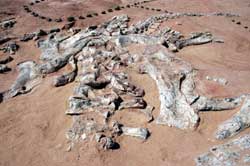A short history of the Sahara in Niger
For several billions years ago...
the earth has turned around the sun. Throughout its history our planet has experienced -- and will continue to experience -- geological changes, climatic shifts and the development of human life.
In the north of Niger, the Air Mountains and the Agadez region have seen these changes in succession: glaciers, seas, rivers, lakes, prairies and deserts. This part of the world, like others, has been witness to life as it appears and evolves. Today, with little vegetation, the geologic wonders of this massif attract the interest of amateur geologists: streaks of pebbles deposited by glaciers on the folds of fossilized sands; geologic chimneys, peaks and volcanic slides; large cliffs of sedimentary rock. The area has undergone phenomenal tectonic forces: the marble stratums of the Blue Mountains and Ilekane, laid down at the horizontal and raised up to the vertical, and the complex ring-like formations of the mountains of Bagzane and Tamgak.
One hundred million years ago ...
 the area stretching from Ingall to Gadoufaoua (including the cliffs of Tiguidit) consisted of plains, marshes, lakes, seas and immense forests which witnessed the evolution of fish, tortoises, crocodiles and dinosaurs. A convergence of extraordinary environmental circumstances resulted in the conservation of nearly complete skeletons of some of the early inhabitants of the area. The region harbors a significant trove of dinosaur skeletons, some measuring 20 meters long and weighing more than 22 tons.
the area stretching from Ingall to Gadoufaoua (including the cliffs of Tiguidit) consisted of plains, marshes, lakes, seas and immense forests which witnessed the evolution of fish, tortoises, crocodiles and dinosaurs. A convergence of extraordinary environmental circumstances resulted in the conservation of nearly complete skeletons of some of the early inhabitants of the area. The region harbors a significant trove of dinosaur skeletons, some measuring 20 meters long and weighing more than 22 tons.
50 kilometers from Agadez a dinosaur walked in the mud; 16 footprints of 50 centimeters remain imprinted in the clay, as if it were yesterday.
Given ongoing silification and erosion, dozens of fossilized tree trunks are now exposed to the sun. Many measure more than 10 meters long and 1 meter in diameter.
Five million years ago ...
the first hominid appeared.
450,000 years ago ...
hominids learned to control and use fire.
Eight thousand years ago ...
 hominids started to make all sorts of tools and to organize themselves into communities for hunting and cultivating. They expressed themselves through art (engravings and rock paintings) until the invention of writing. One day, they discovered the wheel.
hominids started to make all sorts of tools and to organize themselves into communities for hunting and cultivating. They expressed themselves through art (engravings and rock paintings) until the invention of writing. One day, they discovered the wheel.
If you are enthused by archaeology, you will be able to see striking remnants of early human life on our expeditions. From the Air as far as Djado and Kawar there is evidence of the life and culture of these sedentary populations who practiced hunting and fishing in what was then a green environment.
Today this area has been taken over by desert but still reveals multiple traces of its past: skeletons of diverse animals; prehistoric tools from the sites of Tafassasset including axes, arrows, scrapers, flint knives, grindstones, pestles and pottery fragments; graves and funerary monuments from diverse epochs of the Adrar Chiriet; engravings and rock paintings from Iwellen, Dabus, Anakom, Tezirzeit, and Djado..
The soil of the Nigerien Sahara transports us easily to the ancient past of man, but this past is recent to those who try to uncover the mysteries of the Saharan sky and the creation of the universe! The purity of the atmosphere in the desert, the lack of pollution and the vast night sky with no city lights provide our travelers the opportunity to marvel at the endless celestial sky and its myriad of stars. Astronomy enthusiasts will be overwhelmed..
Today ...
The process of desertification has given birth to varying landscapes: a mountain massif stripped bare at its summit, big valleys with patches of green, the huge dunes and immense desert of the Tenere of Tafassasset, arid, flat and waterless.
The area receives rainfall of between 0 and 150 mm per year and the temperatures oscillate between -2 and 45 degrees Centigrade.
Water holes are rare..
Sedentary populations live in desert oases and make their living by hunting, fruit picking and growing crops.
Nomads, well-adapted to the harsh environment and risks of nature, wander through the desert. Touaregs in the Air, the Kanouris of Kawar, the Toubous of Djado and the Peuls Bororo in Azawak practice nomadism, raise livestock and engage in caravan trading.
These traditional ways of life and the economic systems they support are complementary and reflect the delicate balance of the desert environment.